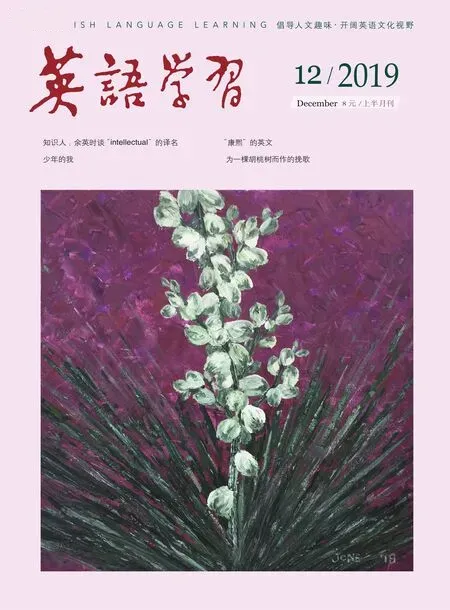“气”的实质
∷ 林巍 文/ 译
原 文
[1]不知道“气”,便不懂得中医,乃至中国哲学与文化。那么,到底什么是“气”?
[2]最早,古人能够看见有形的物体便是“气”,如云雾、热水产生的水汽等,或是那些虽无形但可感知的气态,如空气流动产生的风。后来,“气”逐渐演化为一个哲学概念,指存在于宇宙中不断运动的极细微的本源物质。《易经》说,“天地氤氲,万物化生”;东汉的哲学家王充也认为,“天地合气,万物自生”,即宇宙万物都是由天地之气所构成。
译 文
[1]Without any knowledge ofqi,it will be hard to really get into Traditional Chinese Medicine (TCM),let alone Chinese philosophy and culture.So what exactly isqithen?
[2]In ancient times,people could perceive some tangible objects ofqi,such as clouds vapor and hot steam,or certain invisible though touchable things,such as the flow of air (wind).Later,qievolved into a philosophical concept,referring to a subtle original substance that constantly moves in the universe.The Book of Changesstates that“The heavy fog between heaven and earth bred everything in the universe.”The philosopher Wang Chong in the Eastern Han Dynasty (25—220) possessed the same view:“When the world was amalgamated withqi,myriad substances came into being,”meaning the universe is composed of theqiof heaven and earth.
译 注
[1]这里的“(不)知道”是动词,可译为名词(without any)knowledge。
[2]“万物(自生)”译为myriad substances,还可为all things on earth 等。
原 文
[3]具体而言,正如人体的受精卵由男子的阳气(精子)与女子的阴气(卵子)结合而成;如同受精卵通过不断分裂形成各种细胞,构成各种组织器官乃至整个人体,“气”也是通过不同属性的表达构成了不同的物质,正如老子所言:“道生一,一生二,二生三,三生万物。”
[4]这个哲学概念又被引入了中医理论——认为气是维持人体生命活动的基本组成部分,具有“生命力”,可储存生命器官内的能量。于是,气成为物质和功能的统一体。这一点与爱因斯坦的物质与能量可相互转化的理论相吻合。
[5]根据来源、功能、位置的不同,中医理论又有元气、宗气、营气、卫气;心气、胃气、肺气等等,其作用在于推动体内血液、津液及消化的运行,为人体组织携带营养物质,预防诸如风、寒等外邪的侵袭,把食物转化为有营养作用的精微物质,帮助排泄废物,同时通过循行于经脉和络脉之气来联系、协调不同脏腑、组织、器官在身体内部和表层的功能。
译 文
[3]More particularly,just as a human being is produced by the combination of a man'syang qi(sperm) and a woman'syin qi(ovum) (the fertilized eggs continuously split into cells,form various organs and finally constitute a human body),qihas also been transformed into different substances through evolution.As Lao Zi said,“Dao begets one,one begets two,two begets three and three begets all things on earth.”
[4]This philosophical concept was then introduced into the theory of TCM,holding thatqicomprises essential restorative energies for sustaining organs and lives.In a way,qibecame a unity of material and function,which is very much in line with Einstein's theory of matter-energy mutual transformation.
[5]There are different kinds ofqiin TCM according to their different sources,functions and locations,such as vitalqi,pectoralqi,nutrientqi,defensiveqi,heartqi,stomachqi,lungqiamong many others,to improve blood circulation,the flow of body fluids and digestion;to provide nutrition for body tissues;to prevent the invasion of“external evils”(such as wind and cold);to transform foods into nourishing substances and help excrete wastes;to coordinate functions among different channels connecting various viscera,organs and body parts internally and externally.
译 注
[5]“宗气”指积于胸之气,由脾上输于肺的水谷精气和肺吸入的自然界的清气相合成。其功能主要有两个方面:一是走息道以行呼吸,凡语言、声音、呼吸的强弱,都与宗气的盛衰有关;二是惯心脉以行气血,凡气血的运行,肢体的寒温和活动能力、视听的能力,心搏的强弱及其节律等,皆与宗气的盛衰有关(It refers toqistored in the chest.It is a combination of the essence of food and water in the lungs,which comes from the spleen and the fresh air in the lungs.It has two main functions:First,pectoralqipromotes the respiratory movement through the respiratory tracts and,therefore,has something to do with speaking,voice and respiration;Second,it promotes and adjusts the circulation of blood andqiand,therefore,is associated with the circulation of blood andqi,the temperature and activities of the limbs,visual and auditory ability and heart beat and rhythm.)(原一祥等,2000年版)。“营气”来源于脾胃运化的水谷精气,有化生血液与营养全身的作用(theqiflowing in the blood vessels,which comes from the essence of food and has the functions of generating blood and nourishing the whole body),有的译成ying qi,但译者认为此处用nutrientqi更确切。“津液”指人体一切正常水液的总称,包括各脏腑、组织、器官的内在体液及其正常的分泌物,如涕、泪、胃液、肠液等,是构成人体和维持人体生命活动的基本物质(It is a collective term of all normal liquids including the fluid and normal secretions in all viscera,organs and body parts,such as nasal discharge,tear and gastric and intestinal juice,the necessary make-up of the body.It is the essential substance to maintain vital activities.)。
原 文
[6]特别是中医里的“正气”观念,使人得以培养各种形式的气,增强抵御病菌侵袭和恢复身体健康状态的功能,正如《黄帝内经》所说:“正气存内,邪不可干。”
[7]因此,“气”为人们认识自己的身体、健康提供了独特的视角与能量。
译 文
[6]In particular,the“righteousqi”of TCM enables people to cultivate various forms ofqiand enhance their strength to resist the invasion of germs and restore their health.“When righteousqiis sufficient in the body,no pathogenic factors can hurt it,”as theInner Canon of the Yellow Emperorput it.
[7]Therefore,in this wayqiprovides people with a unique perspective and vigor for them to appreciate their bodies.


